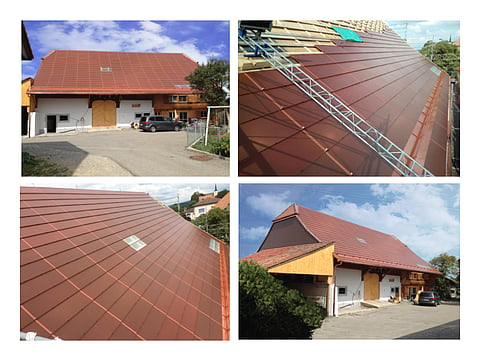

Addressing the concern of integrating PV with historic protected sites, the Swiss Center For Microelectronics and Microtechnologies (CSEM) and module maker Issol have developed solar roof tiles based on standard crystalline silicon cell technology, which were installed on the roof of a farmhouse in Ecuvillens, Fribourg in Swizerland. Keeping in with the aesthetics of the farmhouse, terracotta-red solar panels were integrated into the building roof to allow it to retain its original character.
The solar modules cover 230 m² roof area and were installed by Lausanne-based Solstis.
Electricity generated annually from this installation is expected to be 28 MWh, which would be 20% less than from traditional PV technology. The PV system will power eight four-person homes, the excess energy will be fed into the grid.
Calling it an important milestone, CSEM stated, "In the near future, we will see whether the model developed in Ecuvillens gets replicated on Swiss and European protected sites in order to expand access to this technology ever further, which will play a major role in achieving the objectives of the national energy policy."
It will help the country move closer to the achievement of its Energy Strategy 2050, which doesn't allow any new nuclear plants and supports the expansion of renewable energies of which solar contributed only around 2% to the total in 2016.
This was a pilot project carried out under the country's Department of Energy and the Department of Cultural Property, along with support from the Swiss Federal Office of Energy (SFOE), among others. Studies for the project began in 2014.
One of Europe's leading solar research centers CSEM has developed a technology to make white solar modules, with no visible cells and connections, a reality. It combines a solar cell technology able to convert infrared solar light into electricity and a selective scattering filter, which scatters the whole visible spectrum while transmitting infrared light. Any solar technology based on crystalline silicon can be used to manufacture white – and colored – modules. In August 2017, CSEM announced new conversion efficiencies for III-V/Si multi-junction solar cells as a result of research conducted along with fellow Swiss organization of École Polytechnique Fédérale de Lausanne (EPFL) (see New 35.9% Cell Efficiency Record).
